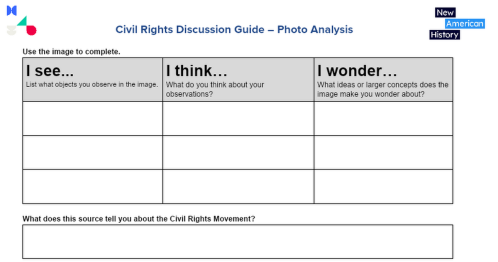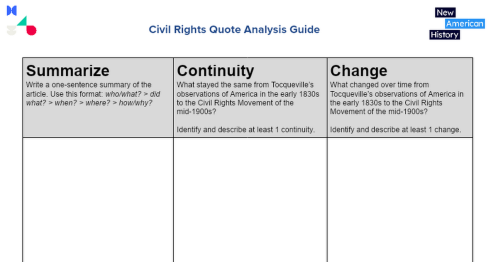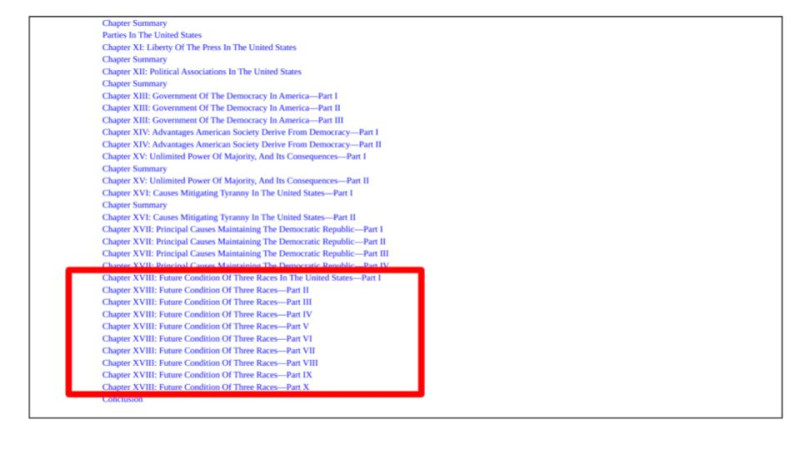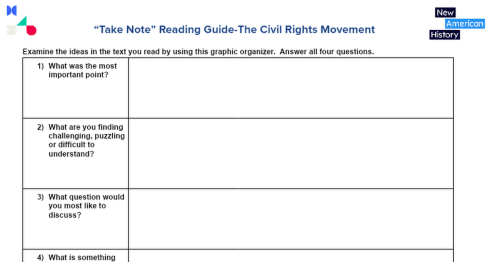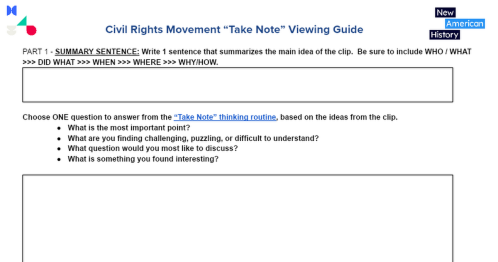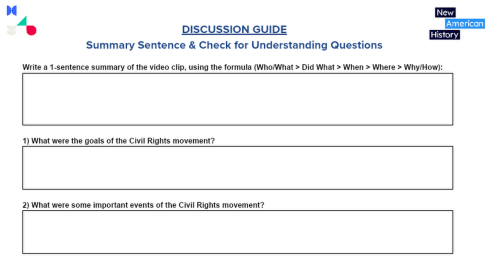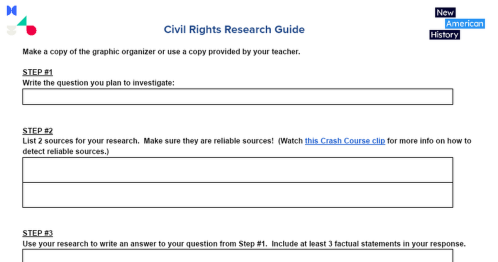This work by New American History is licensed under a Attribution-NonCommercial-ShareAlike 4.0 (CC BY-NC-SA 4.0) International License. Permissions beyond the scope of this license may be available at newamericanhistory.org.
Expanding the Story of America’s Civil Rights Movement
View student version
Standards
C3 Framework:D3.1.9-12. Gather relevant information from multiple sources representing a wide range of views while using the origin, authority, structure, context, and corroborative value of the sources to guide the selection..
National Council for Social Studies:Theme 2 - TIME, CONTINUITY, AND CHANGETheme 5 - INDIVIDUALS, GROUPS, AND INSTITUTIONS
National Geography Standards: Standard 17 - How to apply geography to interpret the pastStandard 18 - How to apply geography to interpret the present and plan for the future.
College Board AP U.S. History (Fall 2020):HISTORICAL THINKING SKILLS COVERED:SKILL 4.A: Identify and describe a historical context for a specific historical process or development.SKILL 5.A: Identify patterns or connections between historical developments.CONTENT COVERED:8.6: Explain how and why the civil rights movements developed and expanded from 1945 to 1960.8.10: Explain how and why various groups responded to calls for the expansion of civil rights from 1960 to 1980.8.11: Explain how and why various groups responded to calls for the expansion of civil rights from 1960 to 1980.
EAD FrameworkTheme: Civic Participation Design Challenge: Motivating Agency, Sustaining the Republic
Suggested Timeframe:One or two 90-minute class periods
Suggested Materials:Internet access via laptop, tablet or mobile device, projection screen, paper/pencil
Key Vocabulary
Civil disobedience - the refusal to comply, obey laws, or pay taxes, usually as a peaceful form of political protest
Jim Crow law - state and local laws that started in the Southern U.S. in the late 1800s that enforced racial segregation
Juxtaposition - the act of placing two ideas side by side to compare them
Marches and boycotts - direct actions used to protest racial segregation
National Urban League - a civil rights group founded in 1910 and based in New York City; advocates for economic and social justice for Black Americans and against racial discrimination in the U.S.
Plessy vs. Ferguson court decision - a landmark U.S. Supreme Court decision ruling that racial segregation laws did not violate the U.S. Constitution as long as the facilities for each race were equal in quality, a doctrine that came to be known as "separate but equal."
Presaged - a sign or warning that (something, typically something bad) will happen
Protest Marches - direct actions used to speak out, draw attention to, or support a cause by leading a walk amongst a community
Reliable source - a source of information that has been verified as trustworthy and that is relatively free of bias
Serfdom - the status of peasants in the social system known as feudalism; common social structure in medieval Europe
Tocqueville, Alexis - a French aristocrat, philosopher, and historian who traveled to the U.S. in 1831 and documented his observations in Democracy in America
Voting Rights Act - a federal law enacted in 1965 that aimed to ensure the right to vote for racial minorities in the U.S., especially in the South
Read for Understanding
Teacher tips
New American History Learning Resources may be adapted to a variety of educational settings, including remote learning environments, face-to-face instruction, and blended learning.
If you are teaching remotely, consider using videoconferencing to provide opportunities for students to work in partners or small groups. Digital tools such as Padlet or Jamboard may also be used for collaboration. Rewordify and Diffit help make a complex text more accessible for those reading at a lower Lexile level while still providing a greater depth of knowledge.
This Learning Resource uses the Turn and Talk strategy to allow students to work with an “elbow partner” for brief collaborations. In addition, this Learning Resource uses “Thinking Routines” from Project Zero, a research center at the Harvard Graduate School of Education that has developed learning strategies that encourage students to add complexity to their thought processes. For an overview of Project Zero’s methodology, you may want to read its Exploring Complexity Bundle. Specifically for this lesson, students will use these thinking routines: Creative Question Starts, Take Note, See, Think, Wonder, I Used To Think… Now I Think.
These Learning Resources follow a variation of the 5Es instructional model, and each section may be taught as a separate learning experience, or as part of a sequence of learning experiences. We provide each of our Learning Resources in multiple formats, including web-based and as an editable Google Doc for educators to teach and adapt selected learning experiences as they best suit the needs of your students and local curriculum. You may also wish to embed or remix them into a playlist for students working remotely or independently.
Engage:
What was America’s Civil Rights Movement?
America’s Civil Rights Movement was one of the most influential social movements in world history in the 20th Century. As popular as it is in the American consciousness, the mainstream story that America tells about the movement is incomplete. It was more than just a handful of people like Rosa Parks, Martin Luther King, Jr., and acts of civil disobedience. This lesson will add more dimensions to the story’s telling.
First, examine this photo.
Use the Turn and Talk strategy with a partner, as well as the See, Think, Wonder thinking routine to organize your conversation.
Discuss the following questions:
- What does this source tell you about the Civil Rights Movement?
- What does this source leave out or not tell you?
Record the ideas you’ve shared using this Civil Rights Discussion Guide for analyzing an image or photograph.
Lastly, present your ideas to the whole class. Your teacher will lead a discussion on these ideas. If working remotely, you may use breakout rooms through videoconferencing, or share via a collaborative document such as Google Docs, Google Slides or a Jamboard.
Your teacher may ask you to record your answers on an exit ticket.
Explore:
How has our thinking evolved about racial issues in early America?
French scholar Alexis de Tocqueville visited the United States of America in 1831 and later published a book of his observations called "Democracy in America." The work remains widely read and quoted by people who study the character of early America before the Civil War.
Dr. Julian Hayter, a historian at the University of Richmond, sees Tocqueville’s ideas as important in understanding the struggle for racial equality in America after Emancipation. Examine the following quote. (Your teacher might project an image of the quote on the board.)
“In thinking about America’s strange juxtaposition of liberty and freedom, [Tocqueville] defined the choices available to slave owners: He said the United States could free enslaved peoples and treat them with some degree of dignity, or perpetuate African American serfdom for as long as possible.” “The possibility of black freedom,” Tocqueville said, “intensified rather than alleviated white prejudices.”
Use the Civil Rights Movement Quote Analysis Guide to analyze the quote.
First, summarize in your own words what the quote means. Then, answer the questions:
What stayed the same from Tocqueville’s observations of America in the early 1830s to the Civil Rights Movement of the mid-1900s?
What changed over time and what stayed the same from Tocqueville’s observations of America in the early 1830s to the Civil Rights Movement of the mid-1900s?
Next, present your ideas to the whole class. Your teacher will lead a discussion on these ideas. If working remotely, you may use breakout rooms through videoconferencing, or share via a collaborative document such as Google Docs, Google Slides, or a Jamboard.
After the discussion, use this digital text to research Tocqueville’s observations on race in America. Select and read a section of Chapter 18 in “Democracy in America,” entitled “Future Condition Of Three Races In The United States.”
Select one of the 10 sections of the chapter on race. Read through and complete the Take Note Reading Guide to record your analysis of the text.
The guide uses the “Take Note” thinking routine. Choose one of these questions to answer using the graphic organizer provided by your teacher, or make a copy of the Google Doc version:
- What is the most important point?
- What are you finding challenging, puzzling, or difficult to understand?
- What question would you most like to discuss?
- What is something you found interesting?
To share your response, your teacher may provide access to a Padlet or Jamboard discussion board, or allow you to collaborate on a Google Slides set. Your teacher will debrief by reviewing the main ideas of each piece and by reading back student responses to the class and asking follow-up questions or by asking you to turn and talk to a partner to share your answers
Your teacher may ask you to record your answers on an exit ticket.
Explain:
What is the traditional story of America’s Civil Rights Movement?
America’s Civil Rights Movement was a resistance against the Jim Crow laws created by the Plessy vs. Ferguson court decision in 1896. The movement is best known for the acts of civil disobedience that gained widespread media attention in the 1950s and 1960s in the U.S. and around the world.
- First, view this segment of the New American History video, The Civil Rights Movement, "Alexis de Tocqueville," narrated by Dr. Julian Hayter, a historian at the University of Richmond. In the video, Dr. Hayter connects Tocqueville’s ideas to the Civil Rights Movement.
After you watch, complete the Viewing Guide.
The guide uses the “Take Note” thinking routine:
- What is the most important point?
- What are you finding challenging, puzzling, or difficult to understand?
- What question would you most like to discuss?
- What is something you found interesting?
(Your teacher may allow you to rewind and rewatch the video as needed to complete your Viewing Guide.)
Next, present your ideas to the whole class. Your teacher will lead a discussion on these ideas. If working remotely, you may use breakout rooms through videoconferencing, or share via a collaborative document such as Google Docs, Google Slides or a Jamboard.
After the discussion, watch another segment of the video, The Civil Rights Movement, "African Americans and Full Citizenship," as narrated by Dr. Julian Hayter. In this segment, he explains how African Americans living in the southern United States were not full U.S. citizens until 1965, the year of the Voting Rights Act.
After you watch the second segment, use the “Think, Pair, Share” Thinking Routine to examine the clip’s ideas with a partner by answering the following question: How were Southern African Americans not full U.S. citizens until 1965?
After your partner discussion, record your ideas in this Segregation Discussion Guide.
Your teacher will then lead a whole-class discussion, in which students share ideas discussed in their partner groups.
After the whole-class discussion, watch a third segment of the video, The Civil Rights Movement, "Marches and Boycotts," narrated by Dr. Julian Hayter. In this segment, he explains the traditional narrative of the Civil Rights Movement that includes Rosa Parks, Martin Luther King, Jr., protest marches, and boycotts.
On your own, complete the final section of the Discussion Guide to check your understanding of the last segment.
Your teacher will then lead a whole-class discussion, in which students share ideas. To share your response, your teacher may provide access to a Padlet or Jamboard discussion board, or allow you to collaborate on a Google Slides set.
Your teacher may ask you to record your answers on an exit ticket.
Elaborate:
How was the Civil Rights Movement more than a direct-action protest?
The Civil Rights Movement of the 1950s and 1960s plugged into a local community organizing movement that was already well established, Dr. Hayter contends. Groups like the National Urban League encouraged leadership development at the local level among ordinary Black men and women, taking the form of voter registration drives and support with employment.
Watch segment four of the video, The Civil Rights Movement, "Local Community Organizing," narrated by Dr. Hayter.
After you watch, turn to a partner. Together, talk through and identify the main claim of Dr. Hayter’s historical argument.
Your teacher will then ask groups to share their claims. Then, complete the “+1 Routine” Thinking Routine.”
In three minutes, make a list of key ideas that grabbed your attention on a blank sheet of paper. Then, pass your paper to one student to your right. Read the list. Take two minutes to expand on an idea, make a new point, or make a connection to another topic. Repeat this process at least two more times. Return the paper to its original owner.
Your teacher will then lead a whole-class discussion, in which students share ideas added to their papers.
Your teacher may ask you to record your answers on an exit ticket.
Extend:
What groups helped define the Civil Rights Movement?
The struggle for civil rights existed long before the 1960s and lasted long after the 1960s (some say into the present era). Civil rights legislation met strong resistance. What groups and ideas came to characterize the Civil Rights Movement?
View the final segment of the video, The Civil Rights Movement, "In Summation," with these last few thoughts from Dr. Julian Hayter.
Conduct further investigations on a topic of your choice. Choose one of the groups or ideas listed below, and complete the Defining the Civil Rights Movement Research Guide:
- National Association for the Advancement of Colored People (NAACP)
- National Urban League
- Congress of Racial Equality (CORE)
- Student Non-violent Coordinating Committee (SNCC)
- Black Nationalism
- Accomodationism
- Civil rights unionism
Your teacher will then lead a whole-class discussion, in which students share their research. To share your response, your teacher may provide access to a Padlet or Jamboard discussion board, or allow you to collaborate on a Google Slides set.
Your teacher may ask you to record your answers on an exit ticket.
Citations:
The Civil Rights Movement. YouTube / The Civil Rights Movement. New American History, 2023. https://youtu.be/HRZeoPWSuAM.
“Crash Course Video #4: Who Can You Trust?” Civic Online Reasoning. Accessed August 3, 2023. https://cor.stanford.edu/videos/who-can-you-trust.
Library of Congress’ Public Domain Archive. “Drinking at ‘Colored’ Water Cooler in Streetcar Terminal, Oklahoma City, Oklahoma.” LOC’s Public Domain Archive, January 1, 1939. https://loc.getarchive.net/media/negro-drinking-at-colored-water-cooler-in-streetcar-terminal-oklahoma-city.
“Project Zero's Thinking Routine Toolbox.” PZ's Thinking Routines Toolbox | Project Zero. Accessed July 6, 2022. https://pz.harvard.edu/thinking-routines.
Tocqueville, Alexis. “Democracy in America.” Project Gutenberg. Accessed July 28, 2023. https://www.gutenberg.org/files/815/815-h/815-h.htm.
“Turn and Talk.” the. Accessed July 6, 2023. https://www.theteachertoolkit.com/index.php/tool/turn-and-talk.
View this Learning Resource as a Google Doc.



